brakes Lancia Musa 2011 Owner handbook (in English)
[x] Cancel search | Manufacturer: LANCIA, Model Year: 2011, Model line: Musa, Model: Lancia Musa 2011Pages: 218, PDF Size: 3.91 MB
Page 92 of 218
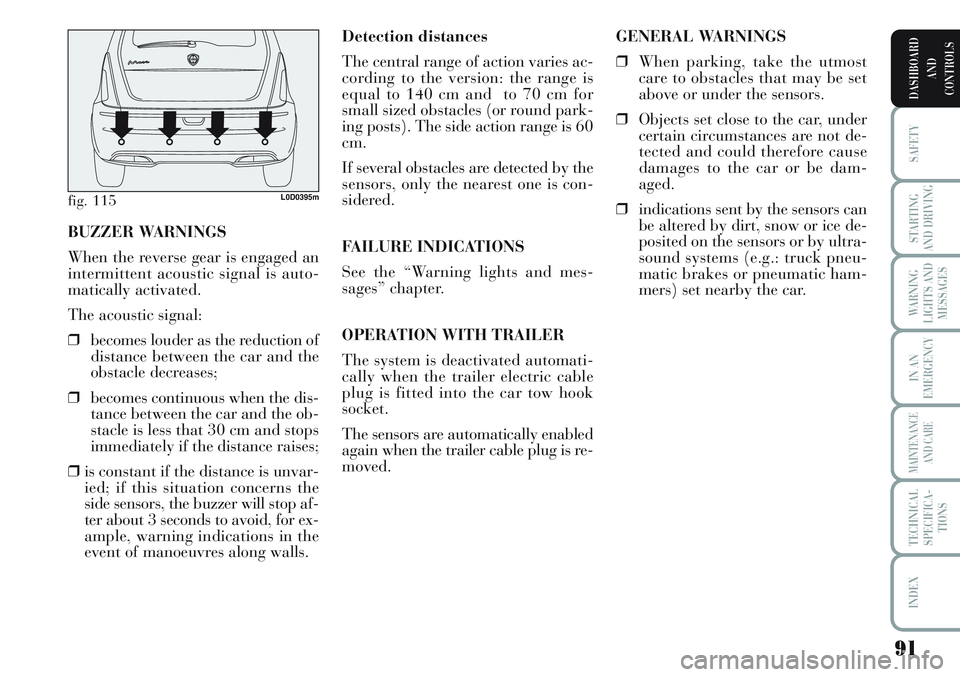
91
SAFETY
STARTING
AND DRIVING
WARNING
LIGHTS AND
MESSAGES
IN AN
EMERGENCY
MAINTENANCE
AND CARE
TECHNICAL
SPECIFICA-
TIONS
INDEX
DASHBOARD
AND
CONTROLS
Detection distances
The central range of action varies ac-
cording to the version: the range is
equal to 140 cm and to 70 cm for
small sized obstacles (or round park-
ing posts). The side action range is 60
cm.
If several obstacles are detected by the
sensors, only the nearest one is con-
sidered.
FAILURE INDICATIONS
See the “Warning lights and mes-
sages” chapter.
OPERATION WITH TRAILER
The system is deactivated automati-
cally when the trailer electric cable
plug is fitted into the car tow hook
socket.
The sensors are automatically enabled
again when the trailer cable plug is re-
moved. BUZZER WARNINGS
When the reverse gear is engaged an
intermittent acoustic signal is auto-
matically activated.
The acoustic signal:
❒becomes louder as the reduction of
distance between the car and the
obstacle decreases;
❒becomes continuous when the dis-
tance between the car and the ob-
stacle is less that 30 cm and stops
immediately if the distance raises;
❒is constant if the distance is unvar-
ied; if this situation concerns the
side sensors, the buzzer will stop af-
ter about 3 seconds to avoid, for ex-
ample, warning indications in the
event of manoeuvres along walls.
fig. 115L0D0395m
GENERAL WARNINGS
❒When parking, take the utmost
care to obstacles that may be set
above or under the sensors.
❒Objects set close to the car, under
certain circumstances are not de-
tected and could therefore cause
damages to the car or be dam-
aged.
❒indications sent by the sensors can
be altered by dirt, snow or ice de-
posited on the sensors or by ultra-
sound systems (e.g.: truck pneu-
matic brakes or pneumatic ham-
mers) set nearby the car.
Page 164 of 218
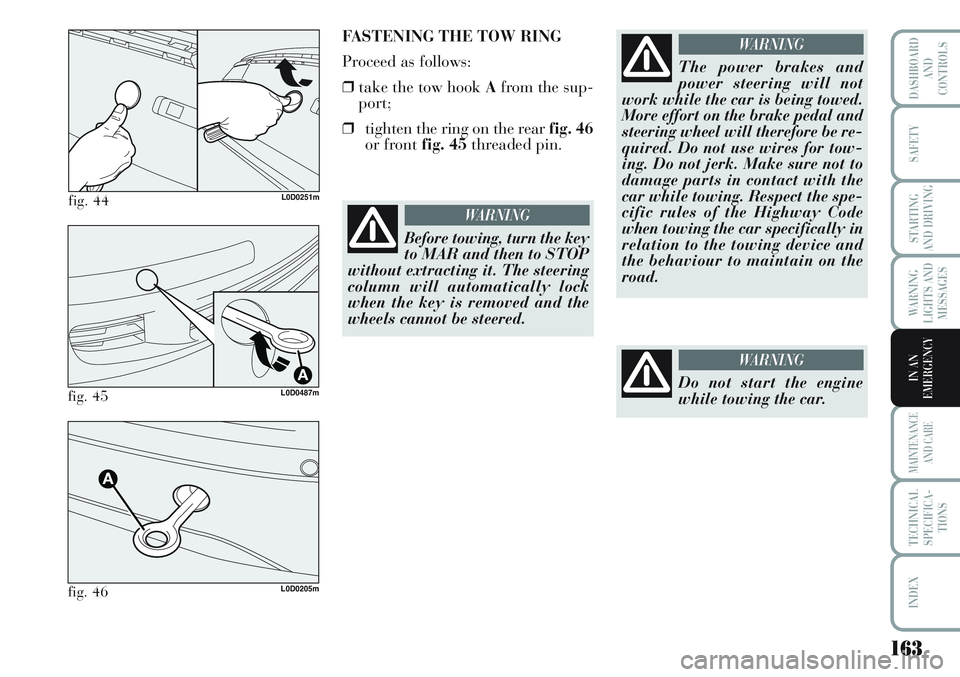
163
WARNING
LIGHTS AND
MESSAGES
MAINTENANCE
AND CARE
TECHNICAL
SPECIFICA-
TIONS
INDEX
DASHBOARD
AND
CONTROLS
SAFETY
STARTING
AND DRIVING
IN AN
EMERGENCY
fig. 44L0D0251m
FASTENING THE TOW RING
Proceed as follows:
❒take the tow hook Afrom the sup-
port;
❒tighten the ring on the rear fig. 46
or front fig. 45threaded pin.
fig. 45L0D0487m
fig. 46L0D0205m
The power brakes and
power steering will not
work while the car is being towed.
More effort on the brake pedal and
steering wheel will therefore be re-
quired. Do not use wires for tow-
ing. Do not jerk. Make sure not to
damage parts in contact with the
car while towing. Respect the spe-
cific rules of the Highway Code
when towing the car specifically in
relation to the towing device and
the behaviour to maintain on the
road.
WARNING
Before towing, turn the key
to MAR and then to STOP
without extracting it. The steering
column will automatically lock
when the key is removed and the
wheels cannot be steered.
WARNING
Do not start the engine
while towing the car.
WARNING
Page 168 of 218
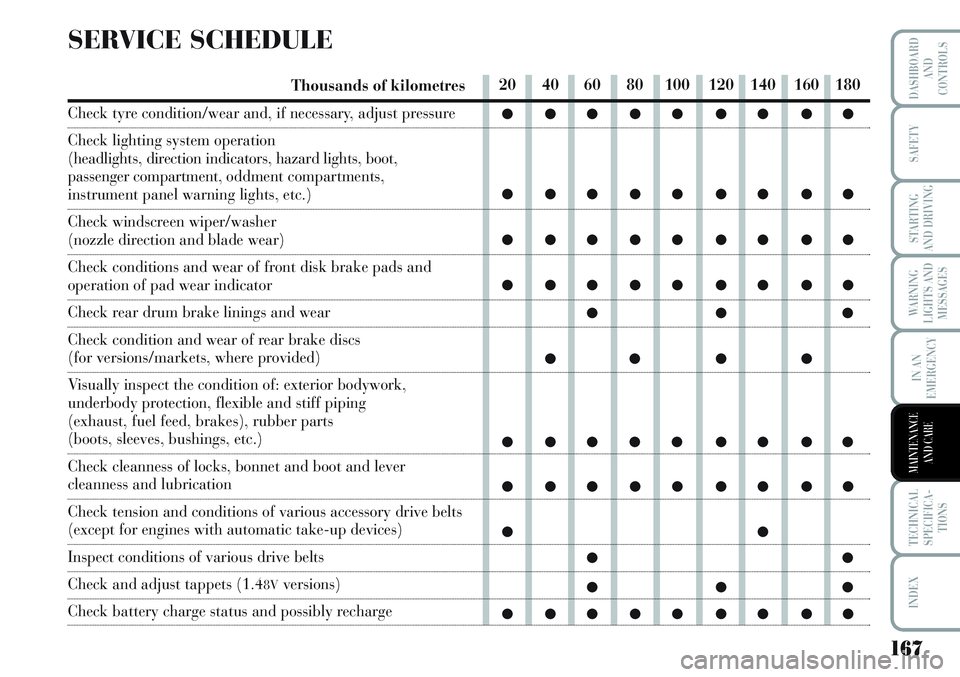
167
WARNING
LIGHTS AND
MESSAGES
TECHNICAL
SPECIFICA-
TIONS
INDEX
DASHBOARD
AND
CONTROLS
SAFETY
STARTING
AND DRIVING
IN AN
EMERGENCY
MAINTENANCE
AND CARE
SERVICE SCHEDULE
Thousands of kilometres
Check tyre condition/wear and, if necessary, adjust pressure
Check lighting system operation
(headlights, direction indicators, hazard lights, boot,
passenger compartment, oddment compartments,
instrument panel warning lights, etc.)
Check windscreen wiper/washer
(nozzle direction and blade wear)
Check conditions and wear of front disk brake pads and
operation of pad wear indicator
Check rear drum brake linings and wear
Check condition and wear of rear brake discs
(for versions/markets, where provided)
Visually inspect the condition of: exterior bodywork,
underbody protection, flexible and stiff piping
(exhaust, fuel feed, brakes), rubber parts
(boots, sleeves, bushings, etc.)
Check cleanness of locks, bonnet and boot and lever
cleanness and lubrication
Check tension and conditions of various accessory drive belts
(except for engines with automatic take-up devices)
Inspect conditions of various drive belts
Check and adjust tappets (1.48Vversions)
Check battery charge status and possibly recharge
20 40 60 80 100 120 140 160 180
●●●●● ●●●●
●●●●● ●●●●
●●●●● ●●●●
●●●●● ●●●●
●●●
●● ● ●
●●●●● ●●●●
●●●●● ●●●●
●●
●●
●●●
●●●●● ●●●●
Page 169 of 218
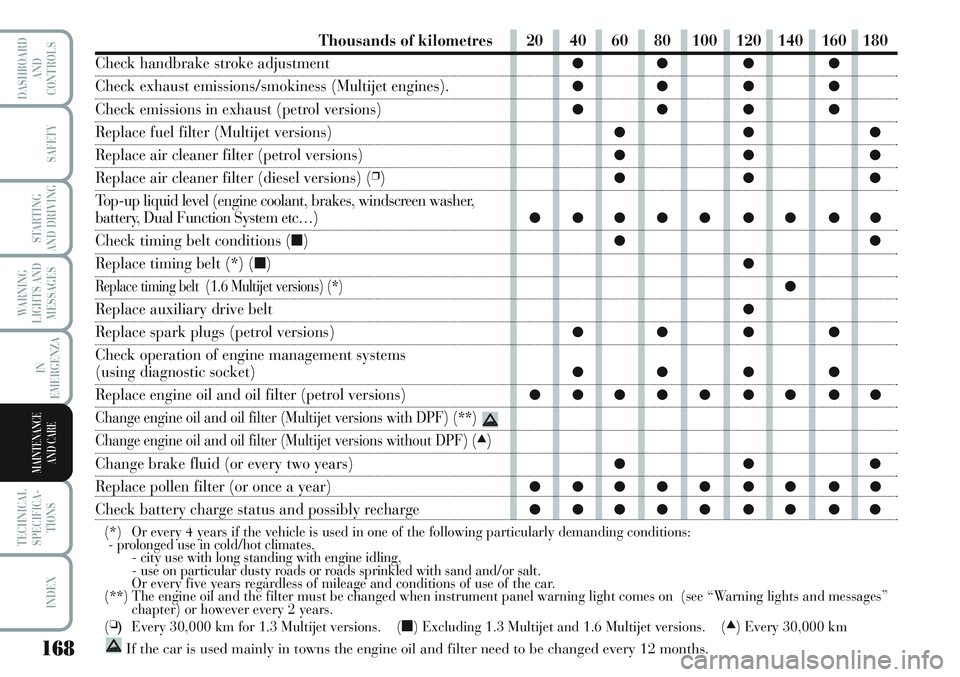
168
WARNING
LIGHTS AND
MESSAGES
TECHNICAL
SPECIFICA-
TIONS
INDEX
DASHBOARD
AND
CONTROLS
SAFETY
STARTING
AND DRIVING
IN
EMERGENZA
MAINTENANCE
AND CARE
Thousands of kilometres
Check handbrake stroke adjustment
Check exhaust emissions/smokiness (Multijet engines).
Check emissions in exhaust (petrol versions)
Replace fuel filter (Multijet versions)
Replace air cleaner filter (petrol versions)
Replace air cleaner filter (diesel versions) (❒)
Top-up liquid level (engine coolant, brakes, windscreen washer,
battery, Dual Function System etc…)
Check timing belt conditions (■)
Replace timing belt (*) (■)
Replace timing belt (1.6 Multijet versions) (*)
Replace auxiliary drive belt
Replace spark plugs (petrol versions)
Check operation of engine management systems
(using diagnostic socket)
Replace engine oil and oil filter (petrol versions)
Change engine oil and oil filter (Multijet versions with DPF) (**)
Change engine oil and oil filter (Multijet versions without DPF) (▲)
Change brake fluid (or every two years)
Replace pollen filter (or once a year)
Check battery charge status and possibly recharge
(*) Or every 4 years if the vehicle is used in one of the following particularly demanding conditions:
- prolonged use in cold/hot climates,
- city use with long standing with engine idling,
- use on particular dusty roads or roads sprinkled with sand and/or salt.
Or every five years regardless of mileage and conditions of use of the car.
(**) The engine oil and the filter must be changed when instrument panel warning light comes on (see “Warning lights and messages”
chapter) or however every 2 years.
(
❏)Every 30,000 km for 1.3 Multijet versions. (■) Excluding 1.3 Multijet and 1.6 Multijet versions. (▲) Every 30,000 km
If the car is used mainly in towns the engine oil and filter need to be changed every 12 months.
20 40 60 80 100 120 140 160 180
●● ● ●
●● ● ●
●● ● ●
●●●
●●●
●●●
●●●●● ●●●●
●●
●
●
●
●● ● ●
●● ● ●
●●●●● ●●●●
●●●
●●●●● ●●●●
●●●●● ●●●●
Page 170 of 218
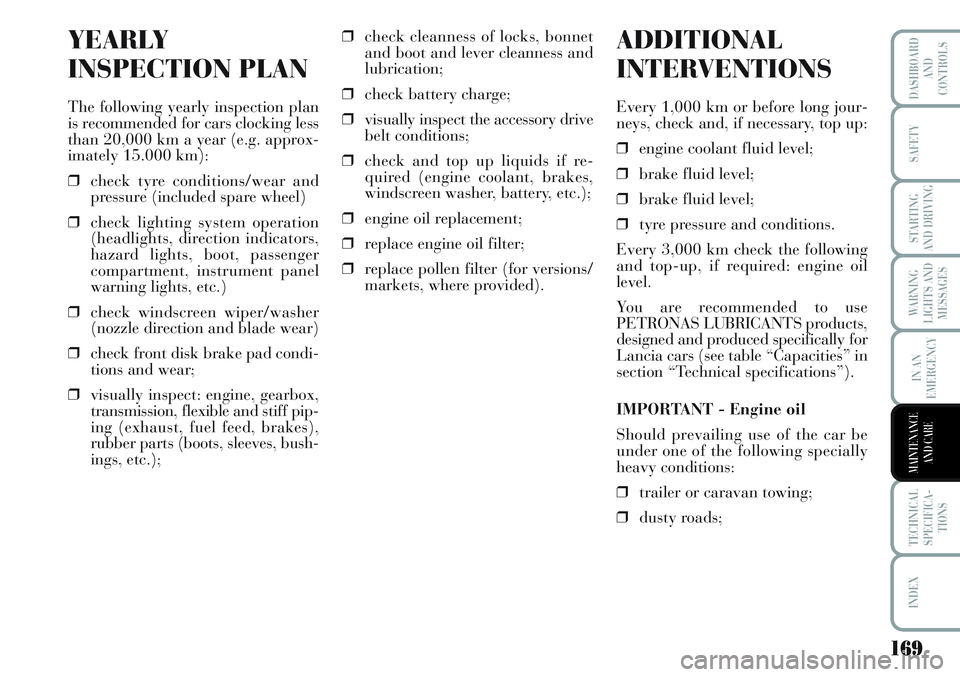
169
WARNING
LIGHTS AND
MESSAGES
TECHNICAL
SPECIFICA-
TIONS
INDEX
DASHBOARD
AND
CONTROLS
SAFETY
STARTING
AND DRIVING
IN AN
EMERGENCY
MAINTENANCE
AND CARE
YEARLY
INSPECTION PLAN
The following yearly inspection plan
is recommended for cars clocking less
than 20,000 km a year (e.g. approx-
imately 15.000 km):
❒check tyre conditions/wear and
pressure (included spare wheel)
❒check lighting system operation
(headlights, direction indicators,
hazard lights, boot, passenger
compartment, instrument panel
warning lights, etc.)
❒check windscreen wiper/washer
(nozzle direction and blade wear)
❒check front disk brake pad condi-
tions and wear;
❒visually inspect: engine, gearbox,
transmission, flexible and stiff pip-
ing (exhaust, fuel feed, brakes),
rubber parts (boots, sleeves, bush-
ings, etc.);❒check cleanness of locks, bonnet
and boot and lever cleanness and
lubrication;
❒check battery charge;
❒visually inspect the accessory drive
belt conditions;
❒check and top up liquids if re-
quired (engine coolant, brakes,
windscreen washer, battery, etc.);
❒engine oil replacement;
❒replace engine oil filter;
❒replace pollen filter (for versions/
markets, where provided).
ADDITIONAL
INTERVENTIONS
Every 1,000 km or before long jour-
neys, check and, if necessary, top up:
❒engine coolant fluid level;
❒brake fluid level;
❒brake fluid level;
❒tyre pressure and conditions.
Every 3,000 km check the following
and top-up, if required: engine oil
level.
You are recommended to use
PETRONAS LUBRICANTS products,
designed and produced specifically for
Lancia cars (see table “Capacities” in
section “Technical specifications”).
IMPORTANT - Engine oil
Should prevailing use of the car be
under one of the following specially
heavy conditions:
❒trailer or caravan towing;
❒dusty roads;
Page 188 of 218
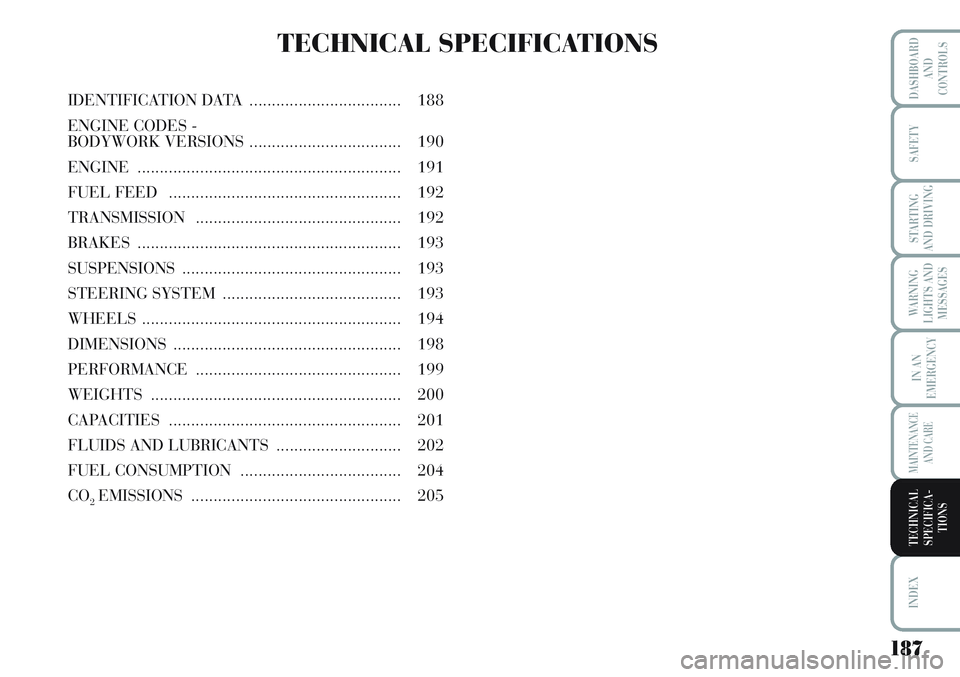
TECHNICAL SPECIFICATIONS
IDENTIFICATION DATA .................................. 188
ENGINE CODES -
BODYWORK VERSIONS.................................. 190
ENGINE........................................................... 191
FUEL FEED .................................................... 192
TRANSMISSION .............................................. 192
BRAKES........................................................... 193
SUSPENSIONS ................................................. 193
STEERING SYSTEM ........................................ 193
WHEELS .......................................................... 194
DIMENSIONS ................................................... 198
PERFORMANCE.............................................. 199
WEIGHTS........................................................ 200
CAPACITIES .................................................... 201
FLUIDS AND LUBRICANTS ............................ 202
FUEL CONSUMPTION.................................... 204
CO
2EMISSIONS ............................................... 205
187
WARNING
LIGHTS AND
MESSAGES
INDEX
DASHBOARD
AND
CONTROLS
SAFETY
STARTING
AND DRIVING
IN AN
EMERGENCY
MAINTENANCE
AND CARE
TECHNICAL
SPECIFICA-
TIONS
Page 194 of 218

BRAKES
Service brakes:
– front
– rear
Parking brake
IMPORTANT Water, ice and salt sprinkled on the roads may deposit on the brake disks reducing braking efficiency the first time the
brakes are applied.
(
▲) Engine version for some versions/markets only 1.4
8V(▲)-1.416V- 1.3 Multijet 70 HP
Self-ventilating discs (257 mm x 22 mm)
Drum (203 mm x 38 mm)
Operated by hand lever, acting on
rear brakes
SUSPENSIONS
Front
Rear
(
▲) Engine version for some versions/markets only 1.4
8V(▲)-1.416V- 1.3 Multijet - 1.6 Multijet
McPherson independent wheels
Semi-independent wheels interconnected by means of torque axle
STEERING SYSTEM
Type
Steering circle
(kerb to kerb) m
(
▲) Engine version for some versions/markets only 1.4
8V(▲)-1.416V- 1.3 Multijet - 1.6 Multijet
Rack and pinion with electric power steering
10,0
1.3 Multijet 90 HP - 1.3 Multijet 95 HP
1.6 Multijet
Self-ventilating discs (284 mm x 22 mm)
1.3 Multijet 90 HP -1.3 Multijet 95 HP: drum
(228 mm x 40 mm)
1.6 Multijet: disc (240 mm x 11 mm)
Operated by hand lever, acting on
rear brakes
193
WARNING
LIGHTS AND
MESSAGES
INDEX
DASHBOARD
AND
CONTROLS
SAFETY
STARTING
AND DRIVING
IN AN
EMERGENCY
MAINTENANCE
AND CARE
TECHNICAL
SPECIFICA-
TIONS
Page 201 of 218

1.48V(▲)-1.416V
1155
500
940
805
1655
1000
400
75
601.3 Multijet
1200
500
940
805
1700
1000
400
75
601.6 Multijet
1275
500
1000
805
1775
1100
500
75
60
WEIGHTS
Weights (kg)
Unladen weight (with all liquids,
fuel tank filled to 90 % and
without optional equipment):
Payload (*)
including the driver:
Maximum permissible loads
(**)
– front axle:
– rear axle:
– total:
Towable loads:
– trailer with brakes:
– trailer without brakes:
Maximum load on roof:
Maximum load on tow hitch
(trailer with brakes):
(*)If special equipment is fitted (sun roof, tow hook, etc.) the unladen weight increases and consequently the payload will
decrease in relation to the maximum permitted loads.
(**) Loads not be exceeded. The driver is responsible for arranging goods in the luggage compartment and/on load carrying platform
within the maximum permitted loads.
(
▲) Engine version for some versions/markets only
200
WARNING
LIGHTS AND
MESSAGES
INDEX
DASHBOARD
AND
CONTROLS
SAFETY
STARTING
AND DRIVING
IN AN
EMERGENCY
MAINTENANCE
AND CARE
TECHNICAL
SPECIFICA-
TIONS
Page 213 of 218
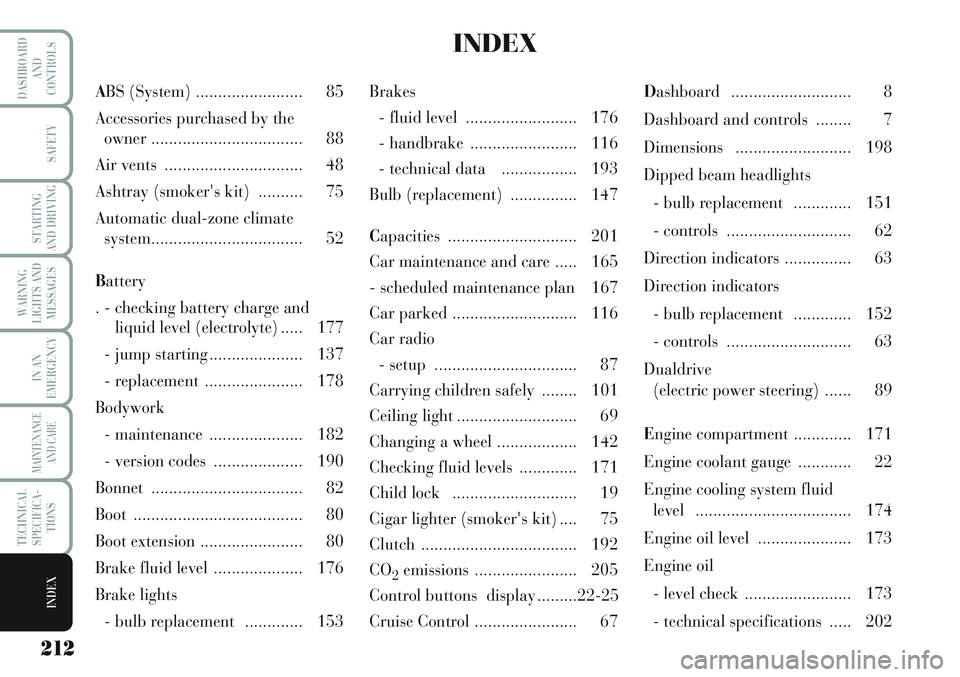
212
WARNING
LIGHTS AND
MESSAGES
DASHBOARD
AND
CONTROLS
SAFETY
STARTING
AND DRIVING
IN AN
EMERGENCY
MAINTENANCE
AND CARE
TECHNICAL
SPECIFICA-
TIONS
INDEX
ABS (System) ........................ 85
Accessories purchased by the
owner .................................. 88
Air vents ............................... 48
Ashtray (smoker's kit) .......... 75
Automatic dual-zone climate
system.................................. 52
Battery
. - checking battery charge and
liquid level (electrolyte) ..... 177
- jump starting ..................... 137
- replacement ...................... 178
Bodywork
- maintenance ..................... 182
- version codes .................... 190
Bonnet .................................. 82
Boot ...................................... 80
Boot extension ....................... 80
Brake fluid level .................... 176
Brake lights
- bulb replacement ............. 153Brakes
- fluid level ......................... 176
- handbrake ........................ 116
- technical data ................. 193
Bulb (replacement) ............... 147
Capacities ............................. 201
Car maintenance and care ..... 165
- scheduled maintenance plan 167
Car parked ............................ 116
Car radio
- setup ................................ 87
Carrying children safely ........ 101
Ceiling light ........................... 69
Changing a wheel .................. 142
Checking fluid levels ............. 171
Child lock ............................ 19
Cigar lighter (smoker's kit) .... 75
Clutch ................................... 192
CO
2emissions ....................... 205
Control buttons display .........22-25
Cruise Control ....................... 67Dashboard ........................... 8
Dashboard and controls ........ 7
Dimensions .......................... 198
Dipped beam headlights
- bulb replacement ............. 151
- controls ............................ 62
Direction indicators ............... 63
Direction indicators
- bulb replacement ............. 152
- controls ............................ 63
Dualdrive
(electric power steering) ...... 89
Engine compartment ............. 171
Engine coolant gauge ............ 22
Engine cooling system fluid
level ................................... 174
Engine oil level ..................... 173
Engine oil
- level check ........................ 173
- technical specifications ..... 202
INDEX